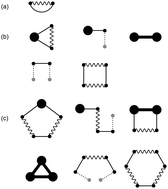A diagrammatic analysis of the variational perturbation method for classical fluids
Abstract
The statistical mechanics of classical fluids can be approached from the particle perspective, where the focus is on the various positions and interactions of the particles, and from the field perspective, where the focus is on the form of the interaction fields generated by the particles. In this work, we combine these two perspectives by examining the variational perturbation method for classical fluids, which has been widely used to describe nonuniform electrolyte systems. Most of this work has been for low orders of the approximation, it has been limited to cases where the electrostatic interactions are weak. We present an exact diagrammatic representation of the method, which greatly facilitates the enumeration and evaluation of higher order corrections to the free energy functional. This framework is able to encapsulate several different approximate theories. Performing a cumulant expansion, leads to the Debye–Hückel and higher order corrections. Including the contribution of chain diagrams leads to a theory closely related to the splitting theory [Hatlo and Lue, Europhys. Lett., 2010, 89, 25002], which has been shown to be accurate from the weak through to the strong coupling limits. Including all chain and ring diagrams leads to the hypernetted chain approximation; this is a more direct route to the conventional derivation, which also requires a renormalization of the Mayer f-bonds to the total correlation functions. These approximations to the variational perturbation method are applied to the classical one-component plasma in order to assess their relative accuracy and understand their relationship to each other. Strategies for developing improved approximations are discussed.

- This article is part of the themed collection: Electrostatics and Soft Matter


 Please wait while we load your content...
Please wait while we load your content...